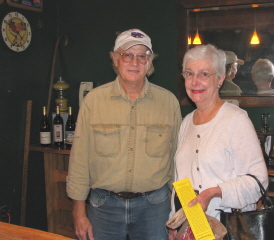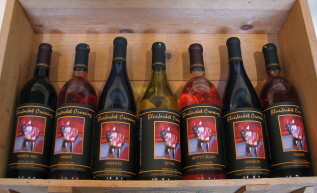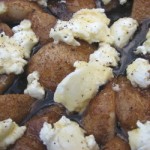
Norton grapes at BlueJacket Crossing winery
A friend and I went on a wine tour Sunday—yes, right here in Kansas, within 25 miles of home. I have to admit my expectations were low. I’d tried some Kansas wines before and hadn’t been impressed. Sunday was different, even though the winemakers were short on dry wines (my preference), due in part to last year’s terrible freeze. Several of the wines we tasted were quite complex, and most of the sweeter wines weren’t cloying, and that’s a good thing—to my taste, anyway.
This was a tour with a purpose. My friend Diane and I are cohosts in the near future of a dinner for a group of wine friends, and this dinner’s featured wines are the local ones. The food will be locally sourced, too. (The timing nicely coincides with The Merc’s Local Food Challenge.) I’ll write again later about what the group thought of the wines, but here’s a look at our tour on a blustery day and our tastings. Allow me to add I’m no wine expert, so don’t laugh at my descriptions!:
Holy-Field Vineyard & Winery
Holy-Field Vineyard & Winery, which is outside Basehor (directions), planted its first wines in 1986 and began selling to the public in 1994. The best-established of the wineries we visited, we came away with Seyval and Corky’s Barrel, a red which the winery describes as off-dry and dedicated to Corky, the vineyard’s mascot Landseer Newfoundland. That fact alone will delight one of our guests, which is good since I failed to note the kind of grape. (Maybe I’ll call later.) In fact, I failed to write anything down, so I’m just going to assume we liked it. The Seyval was “quaffable,” as I recall, relatively dry and tasty.
 Holy-Field’s new plantings
Holy-Field’s new plantings
 Holy-Field’s wall of medals (detail)
Holy-Field’s wall of medals (detail)
Davenport Winery
 Greg and Charlee Shipe operate the Davenport Winery on the site of the orchard that Greg’s grandparents established east of Lawrence. Greg, an old friend of Diane, had no dry wines to offer, but he served us some tasty off-dry and sweet wines that were better than I expected and a nice Port, too. We bought Charlemagne, probably our sweetest purchase of the day, and a bonus: Jonathan apples for 50 cents a pound. (You read that right.) This time, I lost my notes. And honestly, we sipped these wines, so I wasn’t inebriated, just more focused on tasting than reporting, I guess. I’ll do better on the followup post. Really.
Greg and Charlee Shipe operate the Davenport Winery on the site of the orchard that Greg’s grandparents established east of Lawrence. Greg, an old friend of Diane, had no dry wines to offer, but he served us some tasty off-dry and sweet wines that were better than I expected and a nice Port, too. We bought Charlemagne, probably our sweetest purchase of the day, and a bonus: Jonathan apples for 50 cents a pound. (You read that right.) This time, I lost my notes. And honestly, we sipped these wines, so I wasn’t inebriated, just more focused on tasting than reporting, I guess. I’ll do better on the followup post. Really.
 Greg and Diane in the Davenport tasting room
Greg and Diane in the Davenport tasting room
BlueJacket Crossing Vineyard & Winery
 Our third and last stop was at the newest vineyard (as far as I know) in the area, BlueJacket Crossing Vineyard & Winery, which started with planting in 2002. It opened its swank (by local standards, anyway) tasting room this year. We tasted several wines here served by co-owners Vasuki Selvan and Pep Solberg. (Diane, who knows everybody, knows Vasuki, too.) We even got sips of not-yet bottled Norton and Port-style wines. Our purchases: Wolf Red, an off-dry red made from Chambourcin and St. Vincent grapes and aged in American oak, and Vignoles, a sweet white with distinct grapefruit and other citrusy flavors.
Our third and last stop was at the newest vineyard (as far as I know) in the area, BlueJacket Crossing Vineyard & Winery, which started with planting in 2002. It opened its swank (by local standards, anyway) tasting room this year. We tasted several wines here served by co-owners Vasuki Selvan and Pep Solberg. (Diane, who knows everybody, knows Vasuki, too.) We even got sips of not-yet bottled Norton and Port-style wines. Our purchases: Wolf Red, an off-dry red made from Chambourcin and St. Vincent grapes and aged in American oak, and Vignoles, a sweet white with distinct grapefruit and other citrusy flavors.

A selection of BlueJacket Crossing wines
(I forgot to ask, but I’m assuming the vineyard was named for the nearby spot on the Wakarusa River where Shawnee Indian George Blue Jacket operated a hotel and charged a fee for crossing he river. You can read about Blue Jacket’s crossing at the Kansas State Historical Society site.)
We ran out of time and didn’t make it to the Kugler’s Vineyard, but their wines are the only ones we heard about that can be purchased at a local liquor store (Mass Beverage). I’ll report back later on how the wines were received by the wine friends, but I’m happy to say I’m looking forward to the evening rather than trying to figure out how to sneak in wine from somewhere else to fill the gaps. For more on Kansas wines, check out the Kansas Grape Growers and Winemakers Association.





















